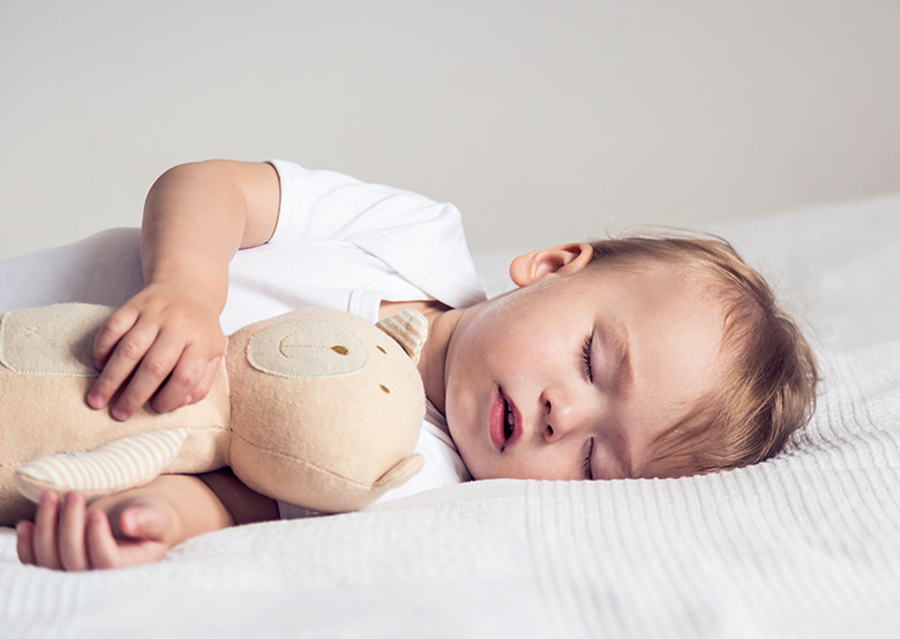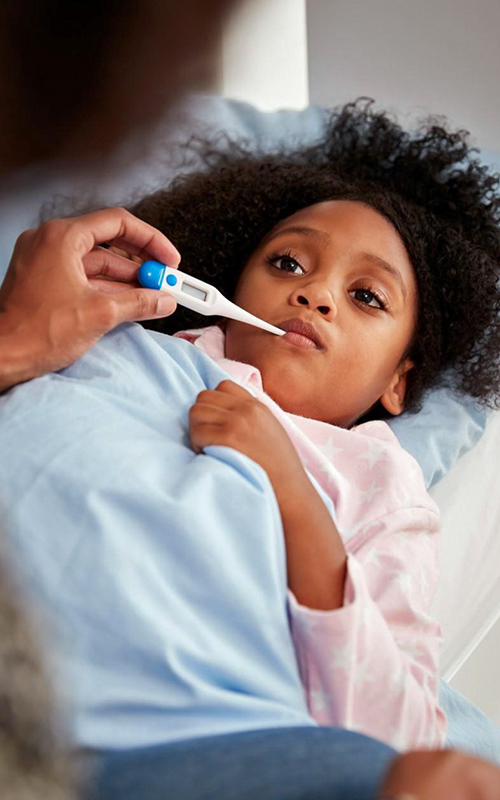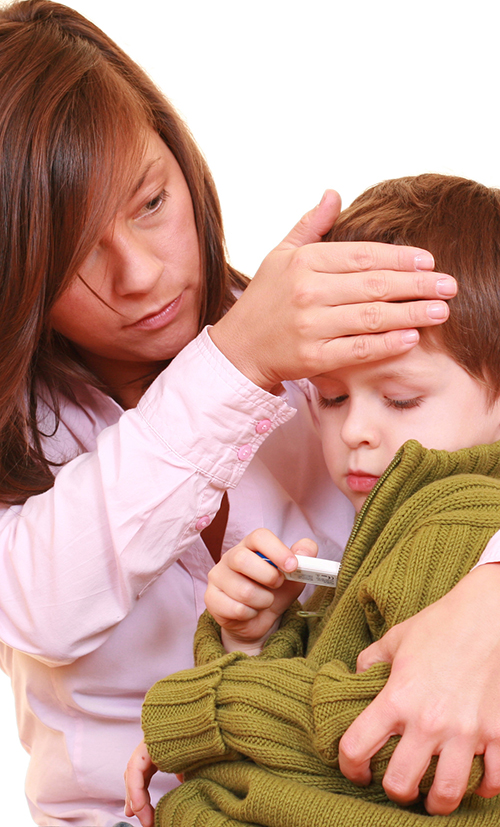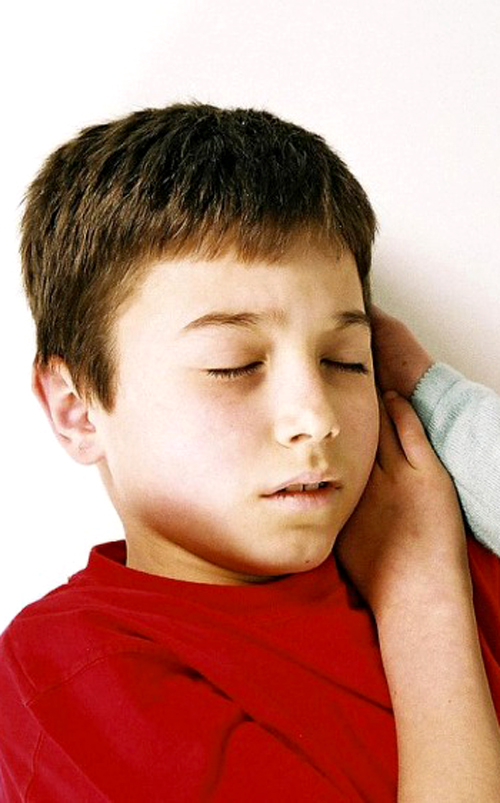Parenting: Fever is Your Friend
Over-bundling, common cause of fever
Feverphobia is rampant in the world of pediatrics these days. Physicians themselves probably are as responsible as anyone for fostering this obsession, taking temperatures on each and every visit, prattling endlessly about the value of alternating acetaminophen and ibuprofen, et cetera.
Treating Fever
Fever is your friend
by Gregory A. Barrett, M.D.
Feverphobia

Of all the symptoms involved in an illness—respiratory effort, heart rate, skin color, degree of irritability, lethargy, state of hydration—the least critical BY FAR is the reading on the thermometer. And yet it’s a fact that more often than not it’s the temperature itself that is the primary concern of the parents.
It is true, an elevated temperature generally indicates that there is an infection. (The rare exceptions would be malignant hyperthermia secondary to an anesthetic or an environmentally induced heat stroke.)

However, the specific height of the temperature does not necessarily correlate at all with the degree of illness. For example, roseola is a viral disease occurring in children between six months and three years of age characterized by a high, primarily nocturnal fever for three to four days, followed by a rose-colored rash appearing on the trunk and face as the temperature returns to normal. This would be a common example of a child manifesting an extremely elevated temperature in the context of a benign, self-limited illness. On the other hand, a child may be deathly ill from a serious infection such as bacterial meningitis in spite of registering ninety-eight point six on the thermometer.
Parents often become obsessed by the temperature and focus on it to the point of becoming distracted from monitoring their child’s other symptoms. They come into the office with exquisitely detailed logs of temperatures, tracking its course hourly for days on end. It is especially disturbing to look at these records and find multiple readings measured even in the middle of the night, which brings up yet another powerful piece of advice:
NEVER AWAKEN A SLEEPING CHILD TO TAKE HIS TEMPERATURE OR GIVE HIM TYLENOL
Or her, either. Seriously! If he or she is sleeping, you don’t care what the thermometer says. Stifle your curiosity and leave your kid alone. The rest their body is getting from sleep is far, far more important in combating the illness than any fever-reducing medication you may wish to give.
Fever is like Pregnancy Test

An elevated temperature is like a pregnancy test in that it is either positive or negative, present or absent. Fluctuations in the fever are just that—fluctuations. There is a circadian (daily) rhythm to our body with the temperature lowest in the morning and peaking between 10 PM and 2 AM. Unfortunately for the mother, the father, and the pediatrician on call, these highest temperature readings coincide precisely with the time when the parents would prefer to go to bed themselves for a worry-free night’s sleep. Just understand that a temp of 103 degrees at bedtime is not really a lot different than a one to three degree lower reading from twelve hours earlier. All of their temperatures rose during the course of the evening, the sick child, the mother, and the father. It happens every night to all of us.
Three Fever Interventions
Often a parent will report with considerable alarm that the child’s temperature actually increased after giving them a dose of ibuprofen or acetaminophen. This information is relayed to us with a sense that something truly bizarre has occurred, but in truth this outcome signifies absolutely nothing.

I believe this concern indicates a major misunderstanding on the part of the parent regarding the purpose of these agents. The three primary interventions used to treat a fever are dressing lightly, administering Tylenol, Motrin, or other such Medication in a therapeutic dose based on the weight of the patient at the suggested interval, and giving a sponge bath in lukewarm water. The goal here is to make the child more comfortable. Period.
Artificially lowering the temperature DOES NOT alter, shorten, or in any way mitigate the course of the illness. None of these measures have any antibacterial or anti-viral capability. If you give your daughter Advil, her temperature drops back down to normal, and she transiently feels a little better, hey, that’s great, but I regret to inform you that you have accomplished nothing as far as actually fighting the infection. Improved comfort is the modest goal of these medications, not resolution of the illness. Therefore, if a teaspoon of Tylenol is administered and the temperature increases, it is no big deal. The purpose wasn’t to make the fever disappear in the first place so don’t be disappointed, your child probably would have felt worse from an even higher temperature without it. The medicine didn’t make the temperature rise—that’s impossible—the infection did.
Besides helping the little patient feel better one other subtle benefit derived from reducing the temperature can be clarification of the cause of the discomfort. If a child is miserable when the fever is high and but is much improved at a lower temperature likely it was only the fever itself making them feel sick. However, if he was lethargic at one hundred and four degrees and feel every bit as bad at one hundred then it could be more due to the underlying illness. There is some value in that observation.
Newborn Fever Concerns
There do exist a couple of specific situations in which the mere presence of a fever itself is a concern. First is the case of the newborn .

Babies in the first six to eight weeks have an enhanced susceptibility to contract infections and, because of their underdeveloped immune systems, these illnesses frequently tend to be of the serious variety. Both because of an awareness of this vulnerability and the extremely limited ability to separate the truly sick from the not-so-sick by physical examination the “better to be safe than sorry” approach results in many a septic work-up (blood culture, bladder catheterization, and spinal tap) being performed on young infants with the solitary, isolated symptom of fever. Pediatricians regard any significant elevation of temperature in the first two months of life as a medical emergency of the first degree.
Interestingly, the most common cause of fever in newborns, particularly in the summer months, is environmental. Newborns are basically cold-blooded. This means that their core body temperature can be either raised or lowered (either direction, mind you) much more easily than an older child or adult. There is a historic tendency to overheat and overdress babies which I believe dates back to a time before modern furnace technology became available. Resetting the thermostat when you come home from the hospital with your newborn to a sultry seventy-nine and/or swaddling her in two onesies, four sleepers, and a woolen Baby blanket does more harm than good. The baby should be dressed in approximately the same degree of clothing that the parent is wearing. If the father is quite comfortable in a diaper and a tee shirt the same would apply to his infant. That is why the first thought which should cross a parent’s mind if their baby is noted to have a slight fever in the month of August and is dressed as described above should be to get the mother-in-law out of the house as quickly and diplomatically as possible. Then, after she has been safely removed, undress your infant, give him a little time to cool down, and retake the temperature. If it is normal you have averted a crisis. If it is still elevated call us immediately.
Febrile Seizures

The other scenario in which fever is not quite so benign is the febrile seizure. A seizure is terrifying to observe, no doubt about it. Although I must have witnessed well over a hundred in my day each and every one gave me an immediate pit in my stomach. I can only imagine how horrifying this must be for parents to have to stand by helplessly and watch their child lose consciousness, roll their eyes back in their head, and thrash the arms and legs convulsively. However, in spite of how gruesome they may appear, the garden variety febrile seizure is actually not all that serious. They are common (occurring in up to four percent of children between six months and five years of age), self-limited (usually lasting less than five minutes), cause no harm to the child during the episode, and are not associated with any long-term adverse neurologic outcomes. A child who has a history of simple febrile convulsions ultimately turns out just the same as those who have never had one. Approximately one out of three children will have an additional seizure associated with a rapid rise in fever at some later time during this age range, so for humane reasons (they do scare the living daylights out of parents) prevention of such a recurrence is a noble and appropriate goal. Thus in these kids a much more respectful and aggressive posture towards treating an elevated temperature is advised.
Rectal, Axillary, Oral, Electronic

The best way to take a child’s temperature remains a subject of ongoing debate. In the first two months of life we’re pretty much stuck with taking the temperature rectally. Unpleasant, yes, but due to the critical importance of precise accuracy and the impracticality of other options there aren’t really effective alternatives. Beyond this age there are any number of options including under the arm, oral, those mood dot thingies you paste on your child’s forehead, so on and so forth. Ear thermometers are particularly quick and can be quite accurate, but as with many things in life the quality of the instrument is directly proportional to the price tag. And please, people, don’t add, subtract, multiply, or divide the temperature reading based upon the orifice in which you placed the thermometer. That confuses the heck out of us. Just report what the temperature reading was, how you took it, and then leave it to your pediatrician to handle the interpretation.
We’ll Believe You
By the way, if you tell us your child has a temperature more often than not, we’ll take you at your word. There was an article published recently which looked at the evaluation of a child’s temperature per maternal touch, and the conclusion was that you moms out there are actually pretty darned good. Dads, I daresay, would be proven to be fairly worthless (“I’m not sure, doc… maybe eighty-five? Heck, I don’t know….” ). The most impressive example I ever saw in this regard occurred one evening during a telephone call I received from a mother regarding her ill three-year-old daughter.
“Does she have a fever?” I inquired in the course of taking a history.

“Yes,” the mom responded assertively.
‘Hmm,’ I thought to myself. There seemed to be quite a bit of action and happy noises going on in the background, usually a giveaway that nothing too terribly bad was happening.
“How high is her temperature?” I asked.
“Just a second, Doc, I’ll find out for you,” she replied. “Lucy!” she bellowed causing my ears to ring before I could jerk the phone away to a safer distance. “Get over here! I want to check your temperature.”
Whiny little girl noises could be heard in the background.
“You can get back to hide-and-seek later, Lucy. I called Aunt May and your cousins can spend the night.”
Sounds of cheering and the clapping of hands erupted. “Lucy, come here!” Thumping of soft feet.
“Hold still. I need to touch your forehead for a minute. Say, did you eat any of them cookies? Those were for Mrs. Jackson, Lucy! She’s been sick and I’m very, very disappointed in you!” More whining…
“We’ll talk about this later.” Vague, incoherent protestations of innocence were heard over what sounded like the cousins resuming their game.
“Lucy, stop squirming!!!”
Ouch. Boy, was that woman loud.
“Doctor Barrett, are you still there?!?”
“Yes,” I said, warily holding the telephone a prudent six inches from my ear.
“Yeah, well, Lucy’s temperature is one hundred…and two…point…. For the last time, Lucy, hold still!!!!! Hold on for a second, Doc! Okay?!?”
“I’m holding,” I winced.
“Alright. It’s one hundred and…two……point……………four.”

Wow. Was she good or what?
Personally, I have only taken my kids’ temperature a couple of times in their lives, and I’ve come to regret it on nearly every occasion. One of the most memorable took place when our firstborn Rachel was just a little over a year old. It was one of those absolutely glorious Saturdays in early spring and, miracle of miracles, my wife had graciously given me the green light to play golf. Now at that particular time of my life, a second-year resident working about a hundred hours a week in the hospital in addition to being the father of a young child, this was indeed a rare and precious opportunity. Needless to say I was up at the crack of a beautiful dawn, washing and cleaning my clubs in anticipation of the day. Unfortunately I committed one crucial error in judgment when I inquired of my better half if there was anything else she needed before I left.
“Rachel felt a little warm to me when I got her up this morning,” she yawned. “Would you mind taking her temperature before you go?”
“Sure, no problem,” I said as I unwrapped a sleeve of shiny new Top Flights and added them to my golf bag. Whistling merrily to myself I held the thermometer under my daughter’s arm while checking my wristwatch. Good, I still had plenty of time to get to the course and hit a few practice balls before our tee time. What a great day! What a wonderful world! How grand it was to be alive….
Uh-oh. Houston, we have a problem.
“It looks like Rachel does have a little bit of a fever,” I muttered nervously, trying to hustle out the front door. “Just give her some Tylenol. She should be fine.”
“What do you mean, ‘a little bit of a fever?’” my wife asked suspiciously, trailing after me and standing in the doorway to our apartment. “How high was it?”
“Uhh, one hundred and three,” I mumbled, opening the trunk.
“One hundred and three?”
“Well, actually a hundred and three point eight. I rounded it down,” I confessed, tossing my clubs in the back.

“You rounded it which way?!?”
“Down.”
“And where do you think you’re going?”
“To play golf, dear. Don’t you remember? You promised,” I pleaded, adding lamely, “Rob will be waiting for me.”
“Take those #%& golf clubs out of the car and get your &!@#* back in here right now!” she said, stamping her foot. “You are not going anywhere!”
Sigh.
She was right, of course. I wasn’t going anywhere. I guess I knew that. But, you see, it was SUCH a beautiful day….
Infections Don’t Cause Fever, the Body Does
The basic science point is this: infections do not cause fever; the body creates fever to form a hostile environment which inhibits the growth and spread of germs. There are any number of elegant studies showing an elevated temperature is actually advantageous to the host. Infected fish will naturally migrate to water with a warmer temperature. Laboratory mice injected with a virus inducing encephalitis will have a dramatically better neurologic outcome if their fever is allowed to rise unabated versus controls in whom the temperature is maintained at a normal level.
In the pre-antibiotic days, a fever was viewed as therapeutic and extreme measures were taken to elevate it to an even higher degree. And in retrospect that may indeed have been theoretically helpful. Nature knows what it is doing, and in the final analysis fever is basically just a primitive adaptation of the body’s defense system to protect the host against infection.
Fever is a symptom, nothing more and nothing less. The true concern should always be the cause of the elevation rather than the degree. Treating a child’s temperature is akin to putting ice on a sprain or a Band-Aid on a boo-boo. Comfort is the goal. If the temperature is increased but your child is acting fine, consider leaving them alone. If it is elevated and he or she feels lousy, sure, go ahead, a little Tylenol or ibuprofen might ease their misery a bit.
Fever is your friend. In its way it is actually helpful, not hurtful. And remember, don’t become so focused on the thermometer readings that you are missing the bigger picture. There are a whole lot of other symptoms to consider in the evaluation of a sick child which are infinitely more critical than the temperature.
☤


